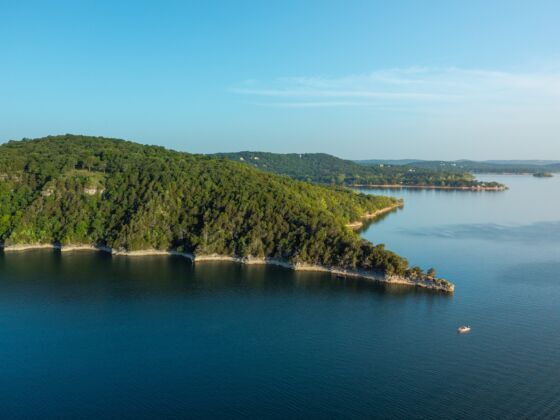Sustainable Travel Guide to the Missouri Outdoors
Because Missouri’s natural landscape is bookended by two major metropolitan cities (St. Louis to the east, Kansas City to the west), it’s easy to overlook its depth and diversity. But between those urban centers, the state encompasses lush forests, native grasslands, pristine lakes and streams, and stunning caves across its five regions. The varied and beautiful outdoor options mean there are opportunities for everyone to explore, whether it’s an afternoon of birdwatching or camping out under the stars after rappelling down the side of a rocky bluff.
As more hikers, nature lovers, and thrill seekers discover Missouri’s natural wonderland, there’s an ever-growing need to protect the places that make the Show-Me State so alluring. Preserving the great outdoors is the mission of Leave No Trace, and by following the Seven Principles of Leave No Trace, you can minimize your own impact on the state’s natural resources.
If celebrating and safeguarding the wonder of nature fits your notion of the ideal vacation, you can do so in every corner of Missouri. Here’s where to go, what to do, and how to be a good steward of our precious planet.

The state’s Northeast region is home to serene prairies, abundant woodlands, and more solitude than anyone would expect to find just an hour outside of St. Louis. Embrace your inner conservationist at Shaw Nature Reserve, Daniel Boone Conservation Area, and Meramec State Park.
Practicing Leave No Trace: Plan ahead for your adventure and prepare for unexpected hazards, emergencies, and weather. If you’re camping, reserve a campsite in advance (many state parks require them). Use existing fire rings, keep it small, and use 2 – 4 gallons of water (not dirt) to put it out.
Stroll the trails: Originally designated an arboretum when the Missouri Botanical Garden first purchased and set aside these 2,400 acres, the spot is now known as Shaw Nature Reserve. Located just 30 minutes west of St. Louis, the reserve has a diverse 17-mile trail system that winds through the area, offering paved, gravel, and dirt trails of distances from less than a mile to several miles long. Maps available at the visitor center distinguish which trails take you through which habitats to help you decide whether you want to wade into the wetlands, stalk through the prairie, or explore woodlands and glades. Note: Tickets are required and can be purchased ahead of time.
Rough it: Rugged adventurers, rejoice. Named after the legendary pioneer, Daniel Boone Conservation Area is the perfect escape into nature for anyone who doesn’t require creature comforts. The primary 6.8-mile, multiuse loop trail accommodates hiking, horseback riding, and mountain biking through woodlands, glades, savannas, and valleys (check for exceptions during deer and turkey hunting seasons). There are multiple primitive campsites, each accessible from a nearby parking lot.
By rope: One of Missouri’s nicknames, “The Cave State,” is on full display at Meramec State Park, where visitors have over 40 known caves to explore and backpackers can trek 13 miles of trails. The park’s most notable attraction is Fisher Cave. Standing beneath the massive 30-foot columns of calcite deposits is worth negotiating some of the narrow passageways it takes to get there. For those who would rather rappel down into the caverns instead of just stare at them, rappelling is allowed on the portion of Green’s Bluff that overhangs Green’s Cave and at the Miller Hollow Quarry. Those wishing to embrace their inner “Mission Impossible” will need a permit and a partner.
Spanning over 7,300 acres of forest, prairie, and wetlands in Northwest Missouri is a historical refuge that provides a habitat for more than 60,000 shorebirds each year, as well as 33 species of mammals, 25 species of reptiles and amphibians, and 20 species of insects. Loess Bluffs National Wildlife Refuge was established in 1935 by President Franklin D. Roosevelt as a breeding ground for birds and other animals. Thanks to parameters put in place to ensure minimal human disturbance, you can enjoy the beauty of the refuge today just as it was then.
Practicing Leave No Trace: Respecting wildlife means quietly observing animals from a distance. Pursuing them or trying to feed them creates significant behavior changes in the animal, which ultimately lead to its inability to survive. And leave those colorful rocks, flowers, plants, and any archeological artifacts as you find them. Leaving interesting objects as they are helps preserve that sense of discovery for those who come after you.
By foot: Hiking the trails that snake across the prairielands or up through some of the more vertical forest terrain of Loess Bluffs National Wildlife Refuge, especially during the spring and fall migration seasons, will yield amazing displays of gathering snow geese and bald eagles. Make your way to the top of the bluffs for an unmatched panoramic view of the refuge.
On two wheels: Hoping to see more, but don’t have as much time? Biking is another great option for exploring the refuge. Multiuse trails are denoted and open to bikers and e-bikers, helping those of all ages and mobility levels make the most of their experience.
Forage in the forest: Visitors are permitted to forage for mushrooms for their own use and consumption. All collecting must take place by hand in designated areas — namely within the forested hills of the Loess Bluffs, located on the east side of US-159.
The Southeast region of the state is home to several sections of Missouri’s only national forest, much of the Ozark Highlands, and many picturesque, towering bluffs. Expect to explore rocky glades, grand oak and pine forests, and winding rivers from multiple perspectives.
Practicing Leave No Trace: Always travel on the designated trails in your park of choice, which helps protect the surrounding ecosystems. Campers in remote areas should pick a campsite where others have camped previously, when possible. Otherwise, make sure to camp on bare soil and at least 100 feet (70 big steps) from a water source. And since outdoor adventures are often better with friends and food, remind those in your group to collect all waste and dispose of it properly — pack in, pack out is the name of the game.
Pedal on: Rugged trails throughout Echo Bluff State Park deliver adrenaline-fueled rides for mountain bikers. After a high-intensity ride, those looking for additional scenic views can traverse the 8-mile Current River Trail or dip into the Roger Pryor Pioneer Backcountry for miles more of wilderness trails.
Float on: Perhaps the most iconic way to experience a Missouri river is by floating it. Pick your craft — tube, kayak, canoe, raft — and prepare for a day of gazing up at gorgeous views of the legendary bluffs that earned Echo Bluff State Park its name.
Ramble on: Mark Twain National Forest, named in honor of the prolific writer born and raised in Missouri, is the state’s only national forest and covers a vast expanse of southern Missouri. Travelers can experience a moment of true solitude while venturing along the seemingly endless trails, perennial streams, and protected semi-primitive habitats. For an extra element of rugged adventure that would impress even the likes of Huckleberry Finn, there are dispersed campsites throughout the forest.
In Southwest Missouri, the sprawling Ozarks and the ever-popular family-vacation destination of Branson attract outdoor enthusiasts looking to explore the vast wooded regions and recreational water activities at Table Rock Lake. For something a bit farther afield, though still replete with family-friendly comforts, check out the peaks and valleys of Dogwood Canyon Nature Park.
Practicing Leave No Trace: Be courteous and considerate of those around you. Everyone enjoys nature in a different way, but loud music, uncontrolled pets, and uncollected litter can ruin the outdoor experience for others. If you need music beyond the birds singing in the trees, try earphones — but at a volume low enough that you can hear those around you. And remember to clean up after pets if they make a mess in camp or on a trail.
By lure: Table Rock Lake’s reputation as one of the best bass fishing locations in the country attracts every level of angler. What’s more, the area’s mild winter temperatures make for nearly year-round fishing opportunities. In addition to bass, look to hook spoonbills, crappies, and bluegills in the lake’s deep blue waters.
By tent: Campers at Table Rock State Park have two basic campgrounds to choose from; try one of the family campsites or platform tent sites for a more niche experience. Bonus: Campers get a 10% discount on rentals and activities from State Park Marina. Aqua Cycle paddleboard, anyone?
By horse: Saddle up at Dogwood Canyon Nature Park, a 10,000-acre area of bluffs, rivers, waterfalls, and woods with several family-friendly amenities to better enable exploration. Among these are stables offering horse rides from one to 2½ hours (fees vary), perfect for those looking to reach areas otherwise inaccessible by bike or on foot.
A serene outdoor escape lies in Missouri’s Central region, encompassing the oak forests and stretches of prairie grasses growing along Clearfork Creek. Two hills, or “knobs,” rising from an otherwise flat region have lent their geographic distinction to the legend of the town of Knob Noster and the nearby state park of the same name.
Practicing Leave No Trace: Craving fresh fish for dinner? Plan ahead and obtain a valid fishing license before reeling in the big one, and be sure to pick up used fishing line to pack it out to the next available trash can. Also, remember to resist the temptation to pick and take home any of the lovely plants you see here.
Hit the paths: Seven trails, ranging from a half-mile to over 7 miles long, run through Knob Noster State Park and its varying habitats. The park — roughly an hour east of downtown Kansas City — is also home to the only official oxbow slough in the state, designated as Pin Oak Slough Natural Area. This unique, natural wetland is a worthwhile destination, especially for flora and fauna enthusiasts who’d like to search for the rare green orchid that grows here.
Cast a line: Anglers of all stripes come to fish Clearfork Creek and the two small lakes set within the park. Bank fishing is the common practice here, and you can expect to catch catfish, bluegill, and bass.
Ride the trails: The “knobs” that inspired the park’s name also make for ideal mountain biking terrain. Those looking for a moderate challenge can take on the McAdoo Trail, a 4.9-mile loop with an elevation gain of 350 feet. The surrounding landscape is particularly beautiful in the fall and spring.

